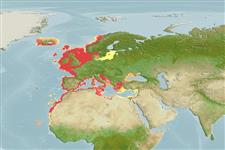Common names from other countries
Classification / Names / Names
Common names | Synonyms | Catalog of Fishes (gen., sp.) | ITIS | CoL | WoRMS
Environment: milieu / climate zone / depth range / distribution range
Ecology
Benthic; depth range 0 - 200 m (Ref. 2754). Subtropical, preferred 16°C (Ref. 107945); 69°N - 15°N, 25°W - 36°E (Ref. 78075)
Eastern Atlantic, Mediterranean and Black Sea: Norway to Senegal and Turkey.
Length at first maturity / Size / Weight / Age
Maturity: Lm ? range ? - ? cm Max length : 10.0 cm SHL male/unsexed; (Ref. 109255); max. reported age: 7 years (Ref. 8702)
Minimum depth from Ref. 114500. This is a sessile-burrower, suspension feeder (Ref. 96498).
Life cycle and mating behavior
Maturity | Reproduction | Spawning | Eggs | Fecundity | Larvae
Members of the class Bivalvia are mostly gonochoric, some are protandric hermaphrodites. Life cycle: Embryos develop into free-swimming trocophore larvae, succeeded by the bivalve veliger, resembling a miniature clam.
Demir, M. 2003. (Ref. 2754)
IUCN Red List Status (Ref. 130435)
CITES status (Ref. 108899)
Not Evaluated
Not Evaluated
Human uses
Fisheries: commercial
| FishSource | Sea Around Us
Tools
Internet sources
Estimates based on models
Preferred temperature
(Ref.
115969): 11.3 - 16, mean 13.8 (based on 32 cells).
Resilience
High, minimum population doubling time less than 15 months (K=0.57; tmax=7).
Vulnerability
Low vulnerability (24 of 100).
